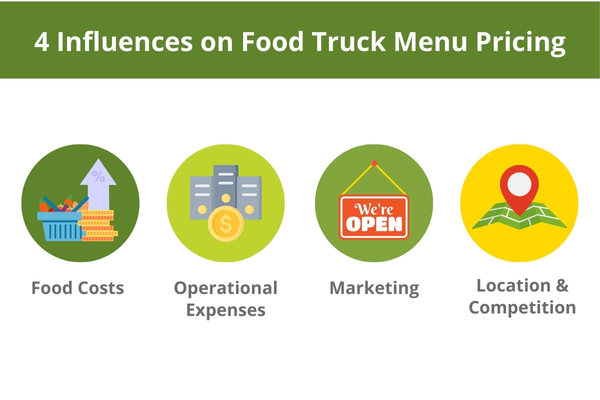
|
How To Price Your Food Truck Menu
June 03, 2024

Starting a food truck is an exciting endeavor! It allows food establishment owners the freedom to experiment with menus and test the waters before going brick-and-mortar. Plus, operating a food truck can be profitable, with potential revenue between $250,000 and $500,000.
Part of a successful food cart business is ensuring your menu pricing covers costs and gives you a healthy profit margin. Looking for info and tips? Read on!
How to Determine Profitable Food Truck Menu Pricing
There’s no one-price-fits-all pricing method for food trucks— every mobile kitchen has unique factors that influence menu costs and prices. However, cost categories and other elements are universal across the board to give operators a solid foundation for pricing, empowering them to craft a menu that's not only profitable but also appealing to their customers.
4 Influences on Menu Pricing
These four factors are essential to creating sustainable menu prices for your food truck.

1. Food Costs
Food costs are among the most critical factors in deciding menu prices. Food costs refer to all the ingredients and supplies needed to prepare each dish. Mobile kitchen owners need to calculate the food cost for each menu item and use that information to determine profitable menu prices. Factors that influence food costs:
- Menu Complexity
- Portion Sizes
- Specialty Ingredients
- To-Go Packaging
Learn more about food cost percentage calculations.
2. Operational Expenses
Additional costs to operate your business should be considered when designing menu prices. Operational costs include:
- Permits and Licenses
- Fuel
- Electricity – heating/cooling
- Rent/Parking Fees
- Maintenance
- Lease
3. Food Truck Marketing
Don’t overlook marketing costs when planning menu prices. While there are plenty of free marketing options, such as social media posts and Google Business Profile, some marketing costs can influence pricing. For example:
- Signage
- Customer Loyalty Programs
- Community Event Partnerships
- Website Development
- Paid social/digital media
- Yelp advertising
- Delivery app preferred placement fee
4. Location and Competition
Location and neighboring competitors can be overlooked in menu pricing strategies. High-demand locations can bump up prices based on location. However, looking at competing food carts and ensuring you don’t outprice your competition is essential. Aim to strike a balance between profitability and accessible pricing.
5 Steps to Calculate Your Food Cart Menu Price
As you can see, a variety of factors contribute to your food truck menu prices. The key is to take the information you have and translate the data into food truck profit. Here are a few tried-and-true methods to calculate pricing.
1. List all your menu items.
2. Determine the costs of goods sold for each food-related item.
3. Factor a baseline profit margin for every dish. Not all menu items will have the same profit margin.
4. Experiment with price points until you reach the ideal profit margin for every plate.
5. Periodically perform a menu audit to determine which items are the most popular and profitable. Consider redesigning your menu to highlight high-profit items.
Money-Savings Pro Tip:
Since menu prices can fluctuate based on ingredients and menu adjustments, save on paper costs with digital signage. Instead of spending time and resources printing and distributing new menus, digital signs allow operators to update costs and offerings on-demand. Upfront costs may be higher, but a digital menu board could ultimately save money on wasted printing materials and lost/unrealized revenue.
Classic Pricing Strategy Methods
If you are new to pricing methods, there are myriads to choose from. Try a few of the strategies below and gauge which is best for your food truck business.
Save on Products at US Foods CHEF’STORE
At CHEF’STORE, we carry all your food truck essentials, including wholesale meat and seafood, fresh produce, eco-friendly paper goods, and more! Visit any of our convenient locations to save on quality ingredients, and don’t forget to take advantage of our business tools to help you further your food truck brand.